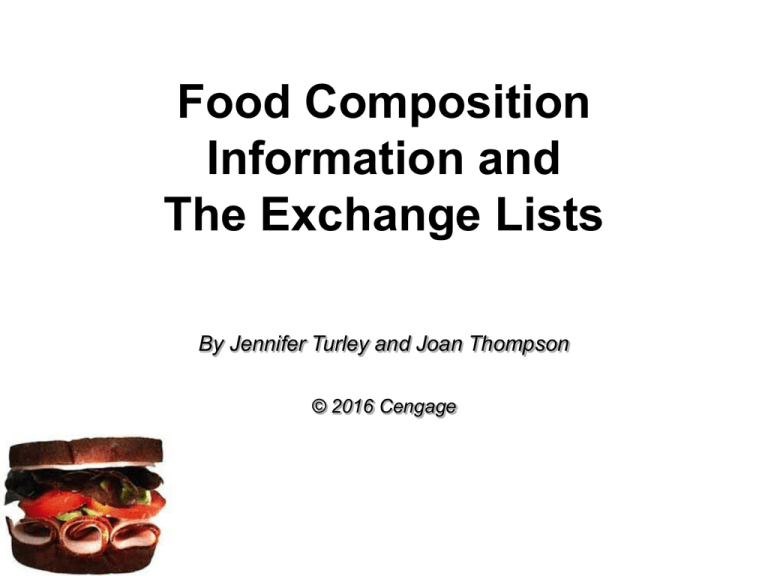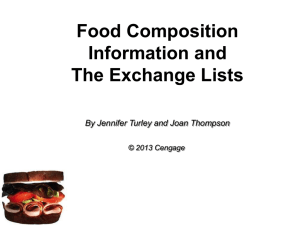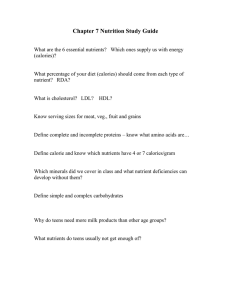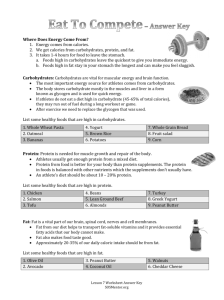Food Composition Information and The Exchange Lists By Jennifer Turley and Joan Thompson
advertisement

Food Composition Information and The Exchange Lists By Jennifer Turley and Joan Thompson © 2016 Cengage Presentation Overview • Food Composition • Chemical composition of food • Used in diet planning & evaluation • The Exchange List System • Purpose • Exchange Lists • Used in diet planning & evaluation • Sample diets Food Composition • Food composition tables & databases provide the chemical composition of foods. • We will use the USDA nutrient databank for food composition values. • http://www.nal.usda.gov/fnic/foodcomp/search/ • Information on the chemical composition of foods can be attained by using the online search option or by downloading the free software database. Let’s take a look at the current release. The Nutrient Data Laboratory • The nutrient database is available through the USDA. • Go online to: http://www.nal.usda.gov/fnic/foodcomp/search/ • There you can see a search option and an option to download software option. Food Composition Tables • The chemical nutrient values are provided given a certain serving size of specific foods. • Chemical values in the USDA nutrient databank include: – – – – Calories Protein, Carbohydrate, Fat (total fat & type of fatty acid) Fat soluble vitamins (A, D, E, K) Water soluble vitamins (thiamin, riboflavin, niacin, folate, vitamin B6, vitamin B12, vitamin C) – Major minerals (sodium, potassium, chloride, calcium, magnesium, phosphorus) – Trace minerals (iron, zinc, iodine, selenium, etc) • Chemical values are also given in some cases the types of amino acids and for phytochemicals (plant chemicals that are not essential nutrients but have many beneficial physiological effects in the human body when consumed from a variety of plant foods). The Exchange Lists System, Part 1 • The Exchange List system is an excellent tool for: • Meal planning • Calorie control • Meeting the AMDRs & DRIs The Exchange Lists System, Part 2 • Was created for diabetic diet planning. • Dietary carbohydrates levels can be planned to be compatible with insulin prescription. • Diet prescription meets standard dietary goals for health. The Exchange Lists System, Part 3 • Portion sizes are based on: • • • • Grams of protein Grams of carbohydrate Grams of fat Total number of Calories (not nutrient content) The Exchange Lists 1. Starch (grains, cereals, pasta, breads, crackers, some snacks, starchy vegetables, dried beans, peas, and lentils) 2. 3. 4. 5. 6. 7. 8. 9. Fruit Nonstarchy vegetables Milk Meat and meat substitutes Fat Other carbohydrates Free foods Combination foods Overview of the Exchange System LISTS Starch Fruit Milk ■ Fat-free, lowfat ■ Reduced-fat ■ Whole Other Carbohydrates Nonstarchy Vegetables CARBOHYDRATE (GRAMS) 15 15 PROTEIN (GRAMS) FAT (GRAMS) CARBOHYDRATE RICH FOODS 3 0-1 — — CALORIES 80 60 12 12 12 8 8 8 0-3 5 8 90 120 150 15 varies varies varies 5 2 — 25 PROTEIN RICH FOODS Meat & Meat Substitutes ■ Very lean ■ Lean ■ Medium-fat ■ High-fat — — — — Fat (P, M, & S) — Free Combination <5 15 7 0-1 7 3 7 5 7 8 FAT RICH FOODS — 5 COMBINATION & FREE FOODS — — varies varies 35 55 75 100 45 <20 varies Exchange Lists A Sample Diet Plan that provides 1735 Calories with 55-60% of its Calories from carbohydrate. 15- 20% from protein and < 30% from fat. Exchange Calories Breakfast Lunch Snack Dinner Snack 9 starch 720 2 1 3 1 4 vegetables 100 3 fruit 180 6 lean meat 330 2 fat-free milk 180 5 fat 225 2 4 1 1 2 1 4 1 1 1 4 Accompanying Meal Plan: Breakfast of cereal with fruit and milk, lunch of a ham sandwich and fruit, snack of popcorn and juice, dinner of pasta with meat sauce, salad sprinkled with seed and dressing, vegetable green beans and corn on the cob and snack of milk and crackers. The detailed exchange lists provide the consumer with an idea of the foods in which quantities count for an exchange. The prescribed exchanges are used up throughout the day. Please see the detailed Exchange Lists appendix Some Summary Points • Food Composition tables and databases: • Show the chemical composition of food based on a specified food portion. • Are used in diet planning & analysis. • The Exchange System Food Lists: • Are used in diet planning and evaluation • Are based on grams carbohydrate, protein, and fat, as well as total Calories provided per food exchange. References for this presentation are the same as those for this topic found in module 2 of the textbook





